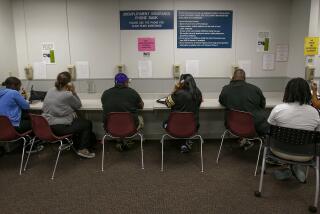Reports on Housing Starts, Factory Rate Point to Slow Growth
- Share via
WASHINGTON — Housing construction fell 2.4% in July, the third consecutive month of weakness, as residential building starts continued to disappoint those looking for a rebound spurred by falling interest rates.
In other pessimistic news, the government also said Friday that the U.S. factory operating rate was frozen at 80.8% in July for the fourth straight month, as U.S. manufacturers continued to be hurt by foreign competition.
The latest reports reinforce recent news on unemployment, business inventories and auto and retail sales, all of which have pointed to continued sluggishness for the economy, not the rebound in the second half hoped for by the Reagan Administration.
“I can’t remember a week when we have had this much bad news come in. Every report has been below market expectations,” said David Wyss, financial analyst at Data Resources, a private forecasting firm. “The housing-start number is just the latest evidence that things are not going to pick up in the second half the way people had hoped.”
The Commerce Department report showed that new housing was built at a seasonally adjusted annual rate of 1.65 million units in July, as a slight advance in single-family construction was overshadowed by a steep drop in apartment building.
Declining Mortgage Rates
The July decline followed a huge 13% drop in May and a weak 0.8% June increase.
This weakness has been occurring against a backdrop of declining mortgage rates, which normally would lead to a rebound in housing activity. Fixed-rate mortgages now stand at about 12.25%, down from a 1984 high of 15.20%.
However, some analysts said the benefits from falling interest rates are being overridden by the weakness in the overall economy.
“We have fairly high levels of consumer debt, consumers are not getting the income gains they did early in the recovery and they are beginning to worry about the future,” said James Christian, chief economist for the U.S. League of Savings Institutions. “Those looking for a big lift from housing in the second half are going to be disappointed.”
The Administration, however, maintained that further gains in housing activity can be expected. A strong housing sector is one of the keys to the Administration’s forecast that growth will rebound to a 5% annual rate in the second half of the year, five times the pace of the first six months.
“Good levels of consumer confidence and small increases in new-home prices relative to other price increases should support renewed improvement in starts during the next few months,” Commerce Secretary Malcolm Baldrige said in a statement.
But many private analysts are predicting that growth in the second half of the year will be at just half the rate forecast by the Administration, held back by slowing consumer demand and the continued stagnation in the industrial sector caused by a flood of imports robbing U.S. manufacturers of sales.
The Federal Reserve said U.S. factories, mines and utilities operated at 80.8% of capacity in July, the fourth consecutive month that the operating rate has been mired at this level. Durable goods manufacturing was frozen at 78.4%, the same as June, while non-durable manufacturing rose 0.1 percentage point to 83.5% of capacity.
While autos and steel showed good gains in July, these increases were held back by widespread declines in other industries, especially electric and gas utilities.
5.6% Decline in May
In the housing report, the Commerce Department said the decline stemmed from a 7.5% drop in construction starts for apartments with five or more units. This followed a 5.6% May decline.
Some analysts attributed this weakness to overbuilding in this segment of the industry and weak rental activity. However, others said builders were growing cautious because of concern about the adverse impact of the Administration’s tax proposals on the profitability of their projects.
Construction of smaller two- to four-unit apartments fell 9.3% in July following an even sharper 11% June decline.
Single-family home activity rose a slight 1.1% in July, reversing a 0.5% June dip.
1.69 Million Units
Building permits, a good sign of future activity, fell 0.9% in July following a 3.7% June decline. However, they still remained at an annual rate of 1.69 million units.
Michael Sumichrast, chief economist for the National Assn. of Home Builders, said this level of building permits should support at least two or three upcoming months of strong housing starts.
The July decline in construction activity was fueled by a giant 31% drop in housing starts in the Northeast. Home building was also down 6.4% in the Midwest but up 6.3% in the South and 4.2% in the West.
More to Read
Inside the business of entertainment
The Wide Shot brings you news, analysis and insights on everything from streaming wars to production — and what it all means for the future.
You may occasionally receive promotional content from the Los Angeles Times.










